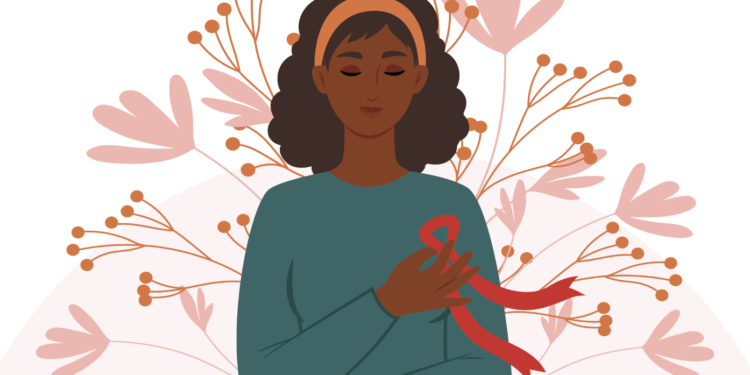March 10th is commemorated as National Women and Girls HIV/AIDS Awareness Day. It is a day to “spark conversation about HIV and highlight prevention methods to reduce HIV” according to the Center for Disease Control (CDC).
Overall, an estimated 1.2 million people have HIV in the United States. Of those, 263,900 are women, according to supplemental reports from the CDC. While celebrating declining cases in recent years, the CDC recognized that nearly 7,000 women received an HIV diagnosis in the United States in 2019. In this data set, that represents 18 percent, or nearly one in five, of the estimated 34,800 new HIV infections in 2019.
That data showed on average that more than ten percent of people with HIV did not know their HIV status, though the figure was lower for women. Unfortunately, while women might know their HIV status at higher rates, compared to all people diagnosed with HIV, “women have lower viral suppression rates.”
For comparison, CDC data showed that for every 100 people overall with diagnosed HIV, when it came to HIV+ women, only 76 received some HIV care, only 58 were retained in care, and only 64 were virally suppressed.
Recognized challenges in achieving and maintaining viral suppression included, “missing multiple doses of HIV treatment, missing medical appointments, or needing other important health care services,” such as dental care or accessing supplemental nutritional assistance and shelter or housing services. Social and economic issues — such as stigma and homelessness — have prevented some women from getting HIV care and treatment.
Importantly, all the CDC data notes that “Data for transgender women are not included because the numbers are too small to report.” This is troubling because “demographic data informs important policy decisions and directs the resources required to implement and execute these policies,” according to the Human Rights Campaign (HRC). However not surprising because HRC noted that “no state has comprehensive laws or regulations requiring all state data collection efforts to include sexual orientation and gender identity alongside other demographic data like race, ethnicity, and sex.”
In discussing prevention challenges specific to women and girls, the CDC focused on identified social barriers such as “racism, discrimination, and HIV stigma,” as particularly impactful.
Additionally, the CDC recognized that PrEP was effective for preventing HIV in women, but that it’s use among women was “very low” because of barriers including “lack of awareness, negative experiences with providers, lack of confidence that providers know about PrEP, daily uptake, and negative response from partner.” Of the population of women who would benefit from taking PrEP, only 10 percent were prescribed it, according to 2019 data.
San Diego
San Diego County recognizes the unique challenges of providing HIV prevention and care services to women and girls but has been meeting those challenges head on for decades thanks to local leaders and non-profits.
Christie’s Place is dedicated to “family-centered and comprehensive social services” and focuses on serving women, children, and families impacted by HIV/AIDS, according to its website. The organization is named in tribute to Christie Milton-Torres, who bravely spoke about her HIV diagnosis in the late 1980s when few women were speaking out about their experiences with HIV.
The organization focuses on a wrap-around psychosocial and multidisciplinary model of care that provides services to the whole family, not just the person with a diagnosis. Today, the organization boasts more than 22,000 annual visits and over 1,400 clients served.
Christie’s Place programs seek to create “communities of support, both in-person and virtual,” through social events, empowerment programming, and evidence-based interventions centered on overall wellness and connection to support individuals in initiating and maintaining “stable HIV care and reduce any feelings of stigma and isolation.”
The organizations service includes a broad range of mental health counseling for individuals, couples, and families, educational trainings, prevention services navigation, testing services navigation, and medical and non-medical case management. Additionally support groups and transportation assistance are also available.
They also receive support from San Diego County to run Project PEARL, which stands for Peers Promoting Equity, Advocacy, and Resourced through Leadership. This is an in-person training opportunity for individuals living with HIV who wish to develop leadership skills and learn more about the San Diego HIV planning process.
Other programs include peer navigators, isolation and stigma-reduction events, empowerment trainings, dancing and hope retreats, and participation in “A Women’s Voice Annual HIV Women’s Conference,” presented by the San Diego CARE Partnership for Women, Children, Youth and Families. This year’s event is hybrid — in-person at The Handlery Hotel and online — and free of charge on Saturday, March 11th from 9 AM to 2:30 PM.
The San Diego County HIV CARE Partnership is a collaboration of consumers, providers and community members that empowers consumers, shares resources, educates the community, advocates for public policy and plans services for women, children, youth and families living with and affected by HIV/AIDS. The group is jointly sponsored by the San Diego HIV Planning Group and Ryan White HIV/AIDS Program Pard D Recipients UC San Diego. The CARE Partnership Committee generally meets on the third Monday of the month, from 11:00 AM to 1:00 PM.
The mission of the HIV Planning Group is to plan HIV prevention, care, and treatment services to reduce the impact of HIV in San Diego County. Anyone in San Diego County can apply to become a member, through the county’s Health and Human Services agency.
A list of San Diego County HIV prevention, treatment and care service providers is available online.









